By Jackie Damrau, Editor
Books Reviewed in This Issue
The reviews provided here are those that are self-selected by the reviewers from a provided list of available titles over a specific date range. Want to become a book reviewer? Contact Dr. Jackie Damrau at jdamrau3@gmail.com for more information.
Experiencing Design: The Innovator’s Journey
by Jeanne Liedtka, Karen Hold, and Jessica Eldridge
Media Capture: How Money, Digital Platforms, and Governments Control the News
by Anya Schiffrin, ed.
An Internet in Your Head: A New Paradigm for How the Brain Works
by Daniel Graham
Planet on Fire: A Manifesto for the Age of Environmental Breakdown
by Mathew Lawrence and Laurie Laybourn-Langton
97 Things Every UX Practitioner Should Know: Collective Wisdom from the Experts
by Dan Berlin, ed.
Getting to the Heart of Science Communication: A Guide to Effective Engagement
by Faith Kearns
Conversations with Things: UX Design for Chat and Voice
by Diane Deibel and Rebecca Evanhoe
Surveys That Work: A Practical Guide for Designing and Running Better Surveys
by Caroline Jarrett
A Spectator Is an Artist Too: How We Look at Art, How We Behave Around Art
by Johan Idema
Lived Experiences of Ableism in Academia: Strategies for Inclusion in Higher Education
by Nicole Brown, ed.
Teaching Business, Technical and Academic Writing Online and Onsite: A Writing Pedagogy Sourcebook
by Sabrani Sen Vengadasalam
Get Hired Now! How to Accelerate Your Job Search, Stand Out, and Land Your Next Great Opportunity
by Ian Siegel
Information Now: A Graphic Guide to Student Research and Web Literacy, 2nd ed
by Matt Upson, Holly Luetkenhaus, C. Michael Hall, and Kevin Cannon
Information Security Essentials: A Guide for Reporters, Editors, and Newsroom Leaders
by Susan E. McGregor
Subconsciousness: Automatic Behavior and the Brain
by Yves Agid
Long Players: Writers on the Albums that Shaped Them
by Tom Gatti, ed.
The Book Proposal Book: A Guide for Scholarly Authors
by Laura Portwood-Stacer
Speculation: A Cultural History from Aristotle to AI
by Gayle Rogers
Tales of the Pen Master: Zen Stories for Editors, Proofreaders, and Other Publishing Professionals
by Jack Lyon
What Are the Chances?: Why We Believe in Luck
by Barbara Blatchley
Educating Tomorrow: Learning for the Post-Pandemic World
by Chris Brown and Ruth Luzmore
Write Here: Developing Writing Skills in a Media-Driven World
by Randi Brummett de Leon and Brooke Hughes
Visual Communication: Insights and Strategies
by Janis Teruggi Page and Margaret Duffy
Bernoulli’s Fallacy: Statistical Illogic and the Crisis of Modern Science
by Aubrey Clayton
Write Faster with Your Word Processor
by Geoff Hart
Design for Safety
by Eva PenzeyMoog
CAPS LOCK: How Capitalism Took Hold of Graphic Design, and How to Escape from It
by Ruben Pater
XQuery for Humanists
by Clifford B. Anderson and Joseph C. Wicentowski
Experiencing Design: The Innovator’s Journey
Jeanne Liedtka, Karen Hold, and Jessica Eldridge. 2021. Columbia University Press. [ISBN 978-0-231-19426-6. 288 pages, including index. US$29.99 (hardcover).]
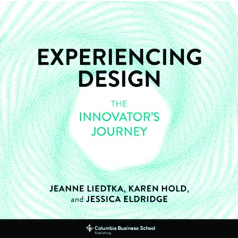 Experiencing Design: The Innovator’s Journey targets professional organizations who want a design methodology that fosters collaboration and innovation. The book lays out the theory and practice of “Design Thinking”: the authors argue this approach creates fundamental mindset shifts in participants and more innovative design outcomes.
Experiencing Design: The Innovator’s Journey targets professional organizations who want a design methodology that fosters collaboration and innovation. The book lays out the theory and practice of “Design Thinking”: the authors argue this approach creates fundamental mindset shifts in participants and more innovative design outcomes.
Design Thinking is a six-stage process of familiar activities structured in an intentional way: “. . . they are sequenced in such a way that their effects are cumulative as the journey progresses. They insist on both action and reflection. As a result, they trigger fundamental shifts in mindsets as well as skillsets” (p. 16, emphasis in original). Through the six stages—immersion, sensemaking, alignment, emergence, imagining, and learning in action—designers learn to engage emotionally with the customer and other team members, finding creative solutions to clearly defined problems.
The first half of the book delves into each stage with helpful charts outlining specific group activities as well as a checklist of questions to evaluate your own mindset as a team member. For example, in Immersion, specific activities like shadowing users, creating journey maps, and performing ethnographic interviews help recalibrate your mindset from an egocentric to empathetic, which leads to better problem definition for your target customers (pp. 36–37).
The latter half of the book is focused on practical application personally and within your organization. The authors present four team member personas (the Driver, the Influencer, the Analyst, and the Supporter); they describe the challenges each persona faces during specific stages of the process and offer facilitator tips to keep team members engaged (p. 146). The Supporter, for example, dislikes inter-personal conflict and may stifle their own good ideas to keep the peace; you can mitigate this by allowing insights to be submitted anonymously and/or enforcing turn-taking in a structured brainstorming session. (pp. 197–198).
Finally, the authors elaborate on personal and organizational development planning and explain the assessment tools included in the appendices to measure a starting point for Design Thinking in your organization. Design Thinking processes foster equity and inclusion in the organization and make team members more invested in strategic planning (pp. 224–225).
Although there is more to dive into in Experiencing Design, there are a couple of takeaways that seem consistent across the Design Learning process. Firstly, disengaging your ego is key: not only does thinking from the perspective of others improve problem identification in the early stages of the process, but it also enables you to let go of bad ideas or even nearly finalized designs further along when they prove lacking in testing (p. 122). Secondly, make it visual: “visualization tools are key drivers behind the transformational power of DT” (p. 98). The human brain is wired for pictures, so make ideas comprehensible by using sketching, videos, user journey maps, or even Lego construction in your design process from brainstorming to prototyping and testing.
Overall, Experiencing Design is well crafted with a balance of theory and practice. I would recommend it to team leaders who want to establish a more intentional design methodology for their organization.
Bonnie J. Shamp Winstel
Bonnie J. Shamp Winstel is the Assistant Manager of Software Development for Book Systems, Inc. in Huntsville, Alabama. She received her master’s degree in English and Technical Communication at the University of Alabama-Huntsville in May 2013.
Media Capture: How Money, Digital Platforms, and Governments Control the News
Anya Schiffrin, ed. 2021. Columbia University Press. [ISBN 978-0-231-18883-8. 316 pages, including index. US$30.00 (softcover).]
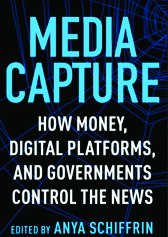 When the news media falls under the control of business tycoons, governments, profit maximizing digital platforms, or special interests, a whole host of ills ensues. The supply of accountability reporting, professionally verified information, and informed debate—the lifeblood of civil society—lessens and gives way to propaganda, demagoguery, trumped-up distractions, and narratives crafted to serve the interests of powerful elites.
When the news media falls under the control of business tycoons, governments, profit maximizing digital platforms, or special interests, a whole host of ills ensues. The supply of accountability reporting, professionally verified information, and informed debate—the lifeblood of civil society—lessens and gives way to propaganda, demagoguery, trumped-up distractions, and narratives crafted to serve the interests of powerful elites.
Media Capture: How Money, Digital Platforms, and Governments Control the News documents how, over the past several decades, media capture has become a global problem that threatens the existence of open and democratic societies.
In a series of chapters written by leading journalists and researchers from around the world, Media Capture provides a sweeping and penetrating analysis of the problem from multiple viewpoints. Together they detail the myriad ways media capture works, and how its effects spill out into the larger society, abetting economic and political corruption, exacerbating such problems as wealth concentration and economic inequality, and warping the public debate on vital issues.
An introductory overview provides historical context and shows how the digital-platform-precipitated collapse of the news media’s traditional advertising-based business model greased the skids for capture. Rich individuals with political agendas buy up financially stressed outlets, while anyone in a position to fund journalism gains the ability to exercise an outsized influence.
Several contributors explore the role that media capture plays in political and economic corruption and in the rise of rightwing demagogues in Hungary, Turkey, India and elsewhere. Others examine the many capture problems plaguing digital news production, among them the compromises forced by insatiable demands for content without respect to quality, and the problem of policing digital payola in open contributor networks. In addition, the platforms, through their outsized influence, and problematic relationship with bad actors, are inviting calls for regulation—much of it highly partisan—that could lead to yet more capture.
Capture can be heavy handed, but it can also use a lighter touch, offering financial and other support, but leaving journalists conflicted over how to cover issues that might annoy funders. A US example examines how a handful of libertarian-minded billionaires have incorporated media capture into their crusade to “reform” and privatize education, funding various philanthropic initiatives and media partnerships to churn out coverage, and even launching their own news outlets.
Arguing that independent journalism is a vital public good and that the for-profit model has largely failed, the last third of Media Capture covers various strategies and proposals for combatting media capture. Among the ideas discussed are alternative forms of financing, including creating trusts for investigative reporting, and a system that would let individuals contribute a small portion of their taxes to a non-profit media outlet of their choice.
Anyone interested in the health of journalism, or in the open society upon which it depends, will find much of value in this essential and deeply-informed book.
Patrick Lufkin
Patrick Lufkin is an STC Fellow with experience in computer documentation, newsletter production, and public relations. He reads widely in science, history, and current affairs, as well as on writing and editing. He chairs the Gordon Scholarship for technical communication and co-chairs the Northern California technical communication competition.
An Internet in Your Head: A New Paradigm for How the Brain Works
Daniel Graham. 2021. Columbia University Press. [ISBN 978-0-231-19604-8. 344 pages, including index. US$30.00 (hardcover).]
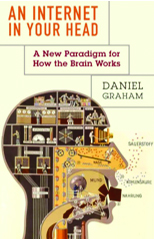 “But metaphors—and especially technological metaphors—have been critical in the history of science, and they will continue to be so as we get closer to understanding the brain” (p. 27). Even before modern technology allowed us to use tracers and imaging techniques on the brain, philosophers and scientists used metaphors to encompass the intricacy and complexity of this critical organ. Seventeenth century philosopher René Descartes likened the brain to the plumbing behind the grand waterworks of the Palace of Versailles—water was pumped uphill from a nearby river—and artfully expelled several meters high on display—delivering more water than was supplied to all of Paris. Building upon this premise, Nobel Prize winner Charles Sherrington likened neurons to “valve-like” structures. Charles Darwin, famous for his work on evolutionary theory, was unable to conceptualize the brain, partly because he had no metaphor for it. He believed thoughts were secreted by the brain, like digestive chemicals. Gottfried Leibniz, co-inventor of calculus, suggested the brain was a type of mill—this suggests different processes operating at different levels. This morphed into the modern-accepted metaphor of the brain as a computer.
“But metaphors—and especially technological metaphors—have been critical in the history of science, and they will continue to be so as we get closer to understanding the brain” (p. 27). Even before modern technology allowed us to use tracers and imaging techniques on the brain, philosophers and scientists used metaphors to encompass the intricacy and complexity of this critical organ. Seventeenth century philosopher René Descartes likened the brain to the plumbing behind the grand waterworks of the Palace of Versailles—water was pumped uphill from a nearby river—and artfully expelled several meters high on display—delivering more water than was supplied to all of Paris. Building upon this premise, Nobel Prize winner Charles Sherrington likened neurons to “valve-like” structures. Charles Darwin, famous for his work on evolutionary theory, was unable to conceptualize the brain, partly because he had no metaphor for it. He believed thoughts were secreted by the brain, like digestive chemicals. Gottfried Leibniz, co-inventor of calculus, suggested the brain was a type of mill—this suggests different processes operating at different levels. This morphed into the modern-accepted metaphor of the brain as a computer.
In An Internet in Your Head: A New Paradigm for How the Brain Works, computational neuroscientist Daniel Graham argues that although the computer metaphor for the brain is helpful and somewhat accurate, it is ultimately obsolete. Many current research observations and discoveries suggest an organ more akin to a network communicator, or an Internet. “There is no doubt that the computer metaphor has been helpful and that the brain does perform computations. But neuroscience based on the computer metaphor is incomplete because it does not consider the principles of network communication. Neuroscientists are starting to realize that, in addition to performing computations, the brain also must communicate within itself” (p. viii).
Graham cites experimental evidence for the flaws in the computer model: In a controlled study of monkey brains compared with a deep net artificial intelligence system, the deep net system predicts less than half of the neuron activity over time. Besides showing the inadequacy of a deep net, this experimental evidence suggests the system is missing the most important signals occurring in the monkey brains.
For the rest of An Internet in Your Head, Graham provides a comprehensive analysis of the ways in which the Internet does and does not correlate to what scientists currently understand about the functionality of the brain. Flexible routing, asynchronous communication, management of errors, background noise, overall growth of the network (and other phenomena) can all be explained in more depth by an Internet-like structure rather than by a computer. Graham argues that a structure of multiple hubs connected in multiple ways creates a net of communication on many different levels. A problem with his analysis is that some of the vocabulary and experimentation is very specific to the field and an understanding of both electronics and neuroscience seems required to follow all the arguments.
And ultimately, scientists don’t have the ability to experiment with the brain’s innerworkings. “Many of the limitations are procedural: it boils down to the fact that living brains, particularly human brains, are difficult to study, whereas single neurons are tractable” (p. 67).
Julie Kinyoun
Julie Kinyoun is an on-call chemistry instructor at various community colleges in Southern California. An avid reader, she enjoys reviewing books that help her become a better educator.
Planet on Fire: A Manifesto for the Age of Environmental Breakdown
Mathew Lawrence and Laurie Laybourn-Langton. 2021. Verso. [ISBN 978-1-78873-877-4. 280 pages. US$24.95 (hardcover).]
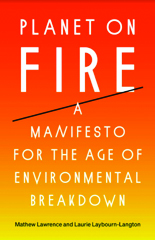 Planet on Fire: A Manifesto for the Age of Environmental Breakdown by Mathew Lawrence and Laurie Laybourn-Langton is a high energy book with a bold, expansive vision for democratizing the state “so it can steer the economy towards sustainability and justice” (p. 16). The first three chapters cover how the world has reached the environmental crisis it is currently in, and the second half discusses a vision and strategies for getting out of this crisis. That vision and those strategies are what make and break this book.
Planet on Fire: A Manifesto for the Age of Environmental Breakdown by Mathew Lawrence and Laurie Laybourn-Langton is a high energy book with a bold, expansive vision for democratizing the state “so it can steer the economy towards sustainability and justice” (p. 16). The first three chapters cover how the world has reached the environmental crisis it is currently in, and the second half discusses a vision and strategies for getting out of this crisis. That vision and those strategies are what make and break this book.
“The environmental crisis is fundamentally a crisis of politics” (p. 226), a point that is thoroughly unpacked in the first half. Power and the accumulation of wealth through economic models that support unrestrained and unchecked capitalization are the driving forces of environmental breakdown according to the authors. They also contend that these models cannot be allowed to subsist because the consequences of capitalism are not only environmental; they are also unjust and inhumane.
One strength of Planet on Fire is that it does not dwell on the negative and quickly moves on to their vision and strategies for getting out of this crisis. This vision, which aligns with the Green New Deal, seeks to “dismantle hierarchies of wealth, class, gender, race and power in society, replacing them with democratic relationships and powerful collectives” (p. 77). The problem with the vision and strategies, however, is that the scale is far beyond anything that the average citizen, thus reader, may feel empowered to do anything about. Their way out of this crisis requires rewiring corporate governance, creating a new legal infrastructure and a “network of national and regional social wealth funds” (p. 157), democratizing pension, labor, and energy systems, and so much more. Although well-researched, ambitious, and socially just, I found these chapters alienating because they were written at the system level and required knowledge of finance and economics at that level. Consequently, I was lost, and more important, I felt hopeless about what one individual, I, could do to make any of this happen.
Although I appreciate their vision, it is still unclear to me how any of this can take place, and I did not feel better, but worse, about the current environmental situation after reading this book. In the last chapter they reference how Margaret Thatcher pulled off the same level of transformation that they suggest, but this reference is not helpful for the younger generations who may not know who she is, what she did, or remember her struggle. It may be that Planet on Fire is intended to stimulate new narratives, as they call for in the last chapter, and if that is the beginning of this process, then the book might work in a group situation like a class or book club. My question, though, is do we have time to just now start conversations? A book written on a scale of individual action might have been more effective in inducing action.
Diane Martinez
Diane Martinez is an associate professor of English at Western Carolina University where she teaches technical and professional writing. She previously worked as a technical writer in engineering, an online writing instructor, and an online writing center specialist. She has been with STC since 2005.
97 Things Every UX Practitioner Should Know: Collective Wisdom from the Experts
Dan Berlin, ed. 2021. O’Reilly Media. [ISBN 978-1-492-08517-1. 280 pages, including index. US$44.99 (softcover).]
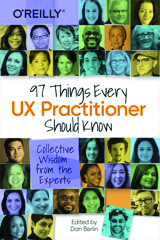 The latest addition of O’Reilly’s 97 Things Every UX Practitioner Should Know: Collective Wisdom from the Experts touches on accessibility, emotional strategy, and other core usability research elements. It follows the publisher’s established pattern for their 97 Things series with two- to three-page essays written by nearly 100 contributors. (Many contributors listed contact information in their bios.) The book is divided into five sections relating to the following topics: career, strategy, design, content, and research. The bulk of essays focus on design and research.
The latest addition of O’Reilly’s 97 Things Every UX Practitioner Should Know: Collective Wisdom from the Experts touches on accessibility, emotional strategy, and other core usability research elements. It follows the publisher’s established pattern for their 97 Things series with two- to three-page essays written by nearly 100 contributors. (Many contributors listed contact information in their bios.) The book is divided into five sections relating to the following topics: career, strategy, design, content, and research. The bulk of essays focus on design and research.
Each section shared useful information for any usability engineer. Readers will find some essays more pertinent than others for their individual career needs. For example, Taylor Kostal-Bergman wrote about learning from your worst job to improve your usability experience (UX) skills. She found some members of immature organizations resistant to UX and states, “. . . it is our responsibility to understand this and work through it” (p. 4). Erin Malone discussed the principles of Gestalt for readers who may not have a design background (p. 63). Benson Chan listed steps to build trust and insight with end users and stakeholders (p. 79). Monet Burse Moutinho explained how to create a reflexivity framework to examine the reader’s own beliefs and how those beliefs affect their work (p. 145). Joe Sokohl cleverly related information architecture to cleaning a basement (p. 40).
97 Things Every UX Practitioner Should Know shares insights from professionals who have spent years in the field. It is an easy read for anyone interested in usability. That said, it is not intended to provide step-by-step tutorials. Readers looking for in-depth knowledge and training about specific facets of user experience will not find that information here. Instead, this book feels like a collection of good blog posts (minus the color and graphics) or an enjoyable chat with a bunch of intelligent colleagues.
Stephanie Saylor
Stephanie Saylor is a technical writer and usability engineer at Yellow Duck Technologies, Inc. She received her master’s degree in digital communication from Johns Hopkins University.
Getting to the Heart of Science Communication: A Guide to Effective Engagement
Faith Kearns. 2021. Island Press. [ISBN 978-1-64283-074-3. 258 pages. US$30.00 (softcover).]
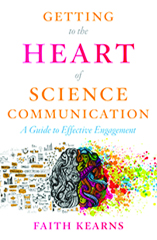 The traditional notion that science communication depends solely on clear explanation of an objectively correct message to a homogeneous “general public” never made much sense. Nonetheless, it became dogma because scientists primarily spoke to members of their own discourse community and rarely looked beyond its bounds. But increasingly, as scientific communication has become its own discipline, repeated and serious communication failures have come under the microscope. This analysis has led practitioners to increasingly embrace a model in which dialogue replaces monologue, since only two-way communication can create the relationships required to persuade an often-adversarial audience to listen to what we’re trying to say.
The traditional notion that science communication depends solely on clear explanation of an objectively correct message to a homogeneous “general public” never made much sense. Nonetheless, it became dogma because scientists primarily spoke to members of their own discourse community and rarely looked beyond its bounds. But increasingly, as scientific communication has become its own discipline, repeated and serious communication failures have come under the microscope. This analysis has led practitioners to increasingly embrace a model in which dialogue replaces monologue, since only two-way communication can create the relationships required to persuade an often-adversarial audience to listen to what we’re trying to say.
In Getting to the Heart of Science Communication: A Guide to Effective Engagement, Faith Kearns reminds us of just how important relationships are in supporting that dialogue. Indeed, “community is foundational” (p. 185), and without a sense of trust and shared purpose (without community), many factors can undermine the dialogue required to ensure that communication happens. Writing from the perspective of a scientist who’s also deeply involved in public outreach, Kearns provides a practitioner’s perspective, supplemented by dozens of examples from working scientific communicators that reveal the pleasures, challenges, and stresses of their work. These human-centered stories are those of communicators from diverse ethnic, cultural, and gender backgrounds. They both reinforce the humanity of scientific communication and its practitioners, and represent concise case studies of how communication succeeds or fails.
An essential insight is that communication is both conscious/rational and subconscious/emotional. Focusing solely on objective facts and how to present them clearly, as most of us have been trained to do, neglects the critical role an audience’s emotions play in shaping their perceptions of our message. This is doubly true when information is filtered through a listener’s preconceptions. Careful listening and a willingness to change or broaden our own beliefs will be required when our goal is to establish a mutually respectful relationship that supports acceptance of our message and motivates change. We must strive to connect, empathize, and support rather than to challenge, contradict, and pressure. Outsiders always face resistance, hostility, and skepticism, particularly if they represent a group that has traditionally neglected, exploited, or even abused the audience. Differences in the power available to speaker and audience raise additional barriers.
Although Kearns focuses on scientific communication, she offers many lessons for communicators in other disciplines who are willing to challenge their worldview. She invites us to “get off the stage and wade into the “mess” along with everyone else” (p. 227) and provides the tools we need to accept that invitation. What improvements might be possible in our ongoing efforts to communicate technical information if we began moving from one-way dictation to two-way dialogue?
Geoff Hart
Geoff Hart is an STC Fellow with more than 30 years of writing, scientific editing, translation, and information design experience. He’s the author of two popular books, Effective Onscreen Editing and Writing for Science Journals.
Conversations with Things: UX Design for Chat and Voice
Diane Deibel and Rebecca Evanhoe. 2021. Rosenfeld Media. [ISBN 978-1-933820-86-1. 322 pages, including index. US$41.99 (digital).]
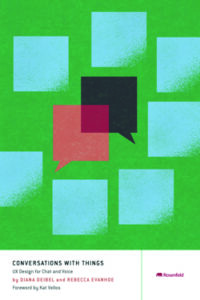 Conversations with Things: UX Design for Chat and Voice provides an approach to the design of conversational systems that includes best practices ranging from an examination of the building blocks of human conversation to considerations for designing inclusive conversations. The book takes on the problem that, despite the growing prevalence of conversational interfaces, or “technolog[ies] that you talk with, whether you’re speaking out loud to it or chatting by typing,” “the technology is a long way from reaching its full potential, in part because people don’t know how to design for interactions where language is the primary way of exchanging information” (p. xvi). For the authors, this problem is rooted in a misunderstanding of both what makes a good conversation and how technology can be designed to imitate good conversations.
Conversations with Things: UX Design for Chat and Voice provides an approach to the design of conversational systems that includes best practices ranging from an examination of the building blocks of human conversation to considerations for designing inclusive conversations. The book takes on the problem that, despite the growing prevalence of conversational interfaces, or “technolog[ies] that you talk with, whether you’re speaking out loud to it or chatting by typing,” “the technology is a long way from reaching its full potential, in part because people don’t know how to design for interactions where language is the primary way of exchanging information” (p. xvi). For the authors, this problem is rooted in a misunderstanding of both what makes a good conversation and how technology can be designed to imitate good conversations.
The authors examine a range of pertinent topics, from how technologies can talk like people (pp. 11–38) to crafting trustworthy artificial personalities (pp. 39–68) to documenting conversational pathways (pp. 127–158) to researching and prototyping actual conversational interfaces (pp. 215–244). In this way, the book contains a complete methodology for conversational design that educates readers on its underlying principles, methods, and important considerations.
If readers have only a passing familiarity with conversational design, they are in for a surprise regarding the sheer breadth and scope of this emerging field. We learn that the field “has its own lingo” even though “people across the industry use different terms for the same thing” (p. xvii). This diversity is highlighted by screenshots of tweets from experts in the field. According to the authors, this lingo includes terms that describe aspects of conversational design that novices to this conversation will undoubtedly be unfamiliar with, such as “voice assistant ecosystem,” “adjacency pair,” “the cooperative principle,” and “affinity bias,” as well as many others (pp. 3, 19, 34, 59). The authors carefully define all terms that provide a background for the field that they describe as a mixture of linguistics, philosophy, and user experience.
The authors also include tips, techniques, and cases of conversation design, ranging from explorations of different types of questions (p. 75) to methods of mapping the pre-programmed flow of conversations (p. 134) to cases in which conversation design has impinged on the right to privacy (p. 208). These tips touch on timely topics such as how to avoid racist stereotypes (p. 57) and the importance of considering the entire gender spectrum (p. 62). Chapter 11 is noteworthy for its savvy introduction to the inclusive design conversation, including further reading on this topic (p. 270).
Overall, readers will find a thorough, nuanced discussion of this emerging field. Though the book doesn’t cover every possible aspect of conversation design, Conversations with Things stands out as a complete and current book on the topic. More importantly, the book is written so a complete novice can understand the topic, but it also contains a wealth of wisdom that seasoned professionals will find useful as a reference guide.
Guiseppe Getto
Guiseppe Getto is a faculty member at East Carolina University. He is also President and Co-Founder of Content Garden, Inc., a digital marketing and UX consulting firm.
Surveys That Work: A Practical Guide for Designing and Running Better Surveys
Caroline Jarrett. 2021. Rosenfeld. [ISBN 978-1-933820-53-8. 372 pages, including index. US$49.99 (softcover).]
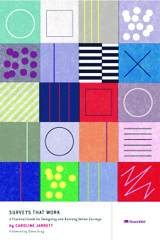 I wish I had read Surveys That Work: A Practical Guide for Designing and Running Better Surveys years ago—before inflicting “big honking” surveys on my poor participants. Fortunately for all of us, Caroline Jarrett’s book is now available, and it’s an indispensable resource for those who employ surveys in their research.
I wish I had read Surveys That Work: A Practical Guide for Designing and Running Better Surveys years ago—before inflicting “big honking” surveys on my poor participants. Fortunately for all of us, Caroline Jarrett’s book is now available, and it’s an indispensable resource for those who employ surveys in their research.
If you’re looking for a book that explains how to write logical survey questions, there’s a chapter on that. Jarrett takes a more comprehensive approach by describing the process of designing, running, compiling, and reporting a survey—not just designing a questionnaire. Jarrett is careful to define “survey” as the research method and distinguishes “questionnaire” as an instrument that fits within the broader surveying process.
Surveys That Work breaks the survey process down to seven essential stages:
- Establish your goals for the survey. At this stage determine your research question—exactly what it is that you want to learn—and what decisions will be made based on the answers. Identify who can help answer your research questions, and what resources and how much time you’ll need. Determine whether a survey is even the best method to answer your research question.
- Find people who will answer. Identify and understand your participants. Identify the burning issue—the topic they really want to talk about. They have needs, wants, time constraints, and privacy expectations that will influence response rates.
- Write the test questions. Make your questions easy to understand. Be sure to address your research question and the participants’ burning issue.
- Build and test the questionnaire. Make your questionnaire easy and interesting for your participants to complete. Test the usability of the survey, modify any problematic questions, and test again.
- Get people to respond. Launch your questionnaire and track completions.
- Turn data into answers. At this point, determine which responses are viable, code your responses, and look for emergent themes.
- Show the results to decision makers. Determine what the story from the survey data describes numerically. Decide how, when, where, and to whom you will present your results.
Interspersed between these chapters are spotlights that focus on specific aspects of surveys that you’ve always wondered about. One spotlight compares four different survey types. Another spotlight explains those ubiquitous Net Promoter Score® surveys. And yet another spotlight explores the quandary of measuring user satisfaction.
Jarrett offers practical guidelines based on years of experience and research. Some “rules” should be taken with a grain of salt. For example, on page 34, Jarrett says “The rule is: [sic] interview first, survey later.” This rule needs to be explained more fully or contextualized. Many dissertations, journal articles, and mixed-methods research projects have employed surveys and then employed follow-up interviews to gather qualitative data that contextualize the quantitative survey data. These studies have used follow-up interviews successfully, which suggests this “rule” requires further investigation.
Jarrett’s conversational style makes Surveys That Work easy to read. Its principles are lavishly illustrated with narrative case studies and colorful images. Whether you’re a seasoned surveyor or a novice trying to navigate this research method, this book offers actionable advice and memorable examples.
Michael Opsteegh
Michael Opsteegh is an STC Associate Fellow and a technical writer in the software and financial services industries since 2004. He is a lecturer in the professional writing program at Cal State Long Beach. Michael holds a master’s degree in English and is a Certified Technical Professional Communicator (CPTC).
A Spectator Is an Artist Too: How We Look at Art, How We Behave Around Art
Johan Idema. 2020. BIS Publishers. [ISBN 978-90-6369-590-3. 176 pages, including index. US$19.99 (softcover).]
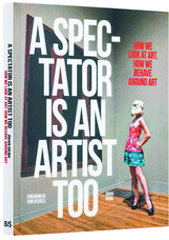 What happens when you see a work of art that is beautiful, puzzling, irritating, or challenging? That is a question posed in the visual feast that is A Spectator Is an Artist Too: How We Look at Art, How We Behave Around Art which itself made me think it—the book—too is a work of art.
What happens when you see a work of art that is beautiful, puzzling, irritating, or challenging? That is a question posed in the visual feast that is A Spectator Is an Artist Too: How We Look at Art, How We Behave Around Art which itself made me think it—the book—too is a work of art.
We can learn something from A Spectator Is an Artist Too to apply to our own work as we imagine how our audiences respond to what we create. The end user is an element, of course, to consider whether you are an artist creating a work of art or a technical communicator creating an end product.
Idema looks at how people interact with art with examples where he shows people looking at works of art and interacting with them. An example is of people almost kissing statues (pp. 84–85). Another example is of people showing a thumbs down to a work of art created by Renoir. Yet another example is of a person standing the same way as a work of art (pp. 66–67) or “photographing your girlfriend” (p. 108).
This made me think of usability testing where we see how people interact with instructions. Of course, people do not interact with instructions by kissing. But they might give instructions a thumbs down.
A Spectator Is an Artist Too also makes a statement about how museum visitors can have a response to art. This response can be casual and creative and certainly not stuffy, reserved, or formal. Idema also makes several statements about Instagram, art museums, and sharing.
Jeanette Evans
Jeanette Evans is an STC Associate Fellow; active in the Ohio STC community, currently serving on the newsletter committee; and co-author of an Intercom column on emerging technologies in education. She holds an MS in technical communication management from Mercer University.
Lived Experiences of Ableism in Academia: Strategies for Inclusion in Higher Education
Nicole Brown, ed. 2021. Policy Press. [ISBN 978-1-4473-5411-6. 336 pages, including index. US$42.95 (softcover).]
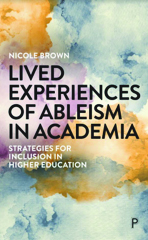 As someone with an invisible disability in academia, I know firsthand how daunting meeting the everyday expectations in a highly competitive environment can be. As Laura L. Ellingson points out in the first chapter, there seem to be few good options for disabled academics, leaving many struggling to work with minimal or no accommodations rather than risk asking for accommodations and being surreptitiously penalized in the tenure and promotion process (p. 27). This is why a book like Lived Experiences of Ableism in Academia: Strategies for Inclusion in Higher Education is so necessary. This collection of narratives, edited by Nicole Brown, is essential reading for both disabled academics and academics wishing to understand their disabled colleagues better.
As someone with an invisible disability in academia, I know firsthand how daunting meeting the everyday expectations in a highly competitive environment can be. As Laura L. Ellingson points out in the first chapter, there seem to be few good options for disabled academics, leaving many struggling to work with minimal or no accommodations rather than risk asking for accommodations and being surreptitiously penalized in the tenure and promotion process (p. 27). This is why a book like Lived Experiences of Ableism in Academia: Strategies for Inclusion in Higher Education is so necessary. This collection of narratives, edited by Nicole Brown, is essential reading for both disabled academics and academics wishing to understand their disabled colleagues better.
Lived Experiences of Ableism in Academia consists of 18 chapters written mostly by disabled British academics in a variety of fields. The authors discuss their experiences with navigating academic life and their experiences with ableism in academia through the lens of personal narratives and auto-ethnographies. The disabilities discussed run the gamut from hearing impairment to autism, mobility impairments, depression, and more. These narratives adeptly frame the issue of disability within the neo-liberal structure of the academy, but at the same time they are touchingly personal and raw. The authors bring to light issues which are normally avoided in the rational world of academics such as grief and loss, learning to readjust after a disability, dealing with both covert and overt ableism, and avoiding internalized ableism.
There are few flaws to this text. The only major issue that I could pinpoint is that because all except one of the authors are from the United Kingdom (UK), some of the discussion might be confusing to readers in other countries with different academic systems and disability laws than those of the UK. There wasn’t much of an effort on most of the authors’ part to clarify these issues for foreign readers with little to no knowledge of these concepts.
Lived Experiences of Ableism in Academia is essential reading for many audiences. I could envision this text as reading for a graduate course in disability studies, or as supplementary reading for graduate students about to enter the academy. However, disabled academics themselves would likely benefit most from reading this text. Many of the narratives so closely mirrored the experiences I have had and the frustration I have felt while struggling with my disabilities that I found myself in tears. It was a massive relief to know that I was not alone in my struggle, and I am sure many other disabled academics would benefit from reading this text as I have.
Nicole St. Germaine
Nicole St. Germaine is a Professor in the Technical and Business Writing Program at Angelo State University, as well as a freelance writer and consultant. Her research interests include technical communication for a Mexican American audience and technical communication in the health fields.
Teaching Business, Technical and Academic Writing Online and Onsite: A Writing Pedagogy Sourcebook
Sabrani Sen Vengadasalam. 2021. Cambridge Scholars Publishing. [ISBN: 978-1-5275-6873-0. 147 pages. US$99.95 (hardcover).]
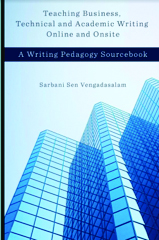 Sabrani Sen Vengadasalam’s Teaching Business, Technical, and Academic Writing Online and Onsite: A Writing Pedagogy Sourcebook is a helpful guide for new instructors and others who are looking for new assignments or approaches for business, technical, and academic writing courses.
Sabrani Sen Vengadasalam’s Teaching Business, Technical, and Academic Writing Online and Onsite: A Writing Pedagogy Sourcebook is a helpful guide for new instructors and others who are looking for new assignments or approaches for business, technical, and academic writing courses.
According to Sen Vengadasalam, there are “three key aspects of facilitating a class successfully: instructional design, participation management, and multimedia use” (p. x). The book is a composite of her previously published articles that address these three aspects through shared assignments, pedagogical approaches, and multimedia resources, most especially in reference to business and technical writing courses. It is divided into two parts and six chapters. Part I consists of a chapter on the importance of project writing that teaches beyond the genre and includes attention to audiences and purposes that extend beyond the classroom and prepares students for workplace writing. Through project writing as described in this chapter, students learn how audience and purpose impact writing. Another chapter explains transformative pedagogy and the importance of scaffolding assignments. And the last chapter in that section addresses the need for and benefits of a graduate or PhD course on Writing for Publications with an interdisciplinary approach to teaching publication writing and use of online peer reviews.
Part II includes chapters on facilitating higher-ordered learning through discussion boards in online classrooms, how to use open educational resources (OER) in business and technical writing courses in ways that promote engagement and enhance learning experiences. In this chapter, she explains that although many educational materials are available on the Internet, instructors may wish to use resources from official OER repository sites of which she shares many options. The chapter is more than just sharing resources and includes best practices for using OER and three distinct ways that they can be used in business and technical writing courses. The last chapter addresses the need for teaching infographics along with best practices and a rubric.
Each chapter includes some sort of approach, rubric, or evaluation scheme denoted by an acronym or abbreviation. I was not sure if that was intentional or not, but such mnemonic devices might be helpful for some readers, especially new instructors. Even though Teaching Business, Technical, and Academic Writing Online and Onsite is a collection of the Sen Vengadasalam’s previously published works, it does have a common theme and the articles do go beyond just sharing assignments and resources by discussing best practices and ways to engage students in deep learning that will benefit them in the workplace. Many of the chapters include sample syllabi, rubrics, and other helpful resources that pertain to the assignments or approaches discussed in those chapters, and there is discussion about various teaching modalities as well. It is, as the title implies, a handy pedagogical sourcebook.
Diane Martinez
Diane Martinez is an associate professor of English at Western Carolina University where she teaches technical and professional writing. She previously worked as a technical writer in engineering, an online writing instructor, and an online writing center specialist. She has been with STC since 2005.
Get Hired Now! How to Accelerate Your Job Search, Stand Out, and Land Your Next Great Opportunity
Ian Siegel. 2021. John Wiley & Sons, Inc. [ISBN 978-1-119-79442-4. 210 pages, including index. US$19.95 (hardcover).]
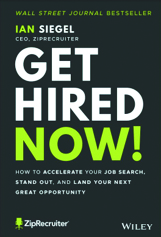 Get Hired Now! How to Accelerate Your Job Search, Stand Out, and Land Your Next Great Opportunity opens with explaining how every interviewer is biased and that 75% of all résumés are read by applicant tracking systems designed to reject you. We found that a discouraging way to open a job-hunting book. However, Ian Siegel did give tips on how to get past said applicant tracking systems.
Get Hired Now! How to Accelerate Your Job Search, Stand Out, and Land Your Next Great Opportunity opens with explaining how every interviewer is biased and that 75% of all résumés are read by applicant tracking systems designed to reject you. We found that a discouraging way to open a job-hunting book. However, Ian Siegel did give tips on how to get past said applicant tracking systems.
It is the reviewers’ opinion that the best way to get a new job is through personal referrals in your network or (even better) being so professionally visible that organizations ask you to work for them. Siegel doesn’t discuss building a professional brand but does talk about online branding (also known as your online footprint). The book then discusses ways to clean up your social media feeds such as purging public-facing posts.
Next, Siegel talks about job hunting using your network or a professional recruiter, which the reviewers’ thought is excellent advice. The next chapter, however, contained advice we felt was wrong, such as apply for online jobs with one click, the best time to apply for a job is one second after it is posted, and feel free to apply for jobs where you only match 40% of the job requirements.
In the final few chapters of Get Hired Now!, Siegel covers the basics of what to wear in an interview, how to respond to interview questions, and so on. This information was overall useful, yet we also disagreed with the quoted statistics (you only get one second to make a good impression?).
In all our speaking and writing engagements, we always tell the audience, “Nothing is true unless it is true for you. Don’t take what we tell you as true without trying it yourself. If it works for you, great! If it doesn’t, modify it for your situation or discard it altogether.”
We would caution you to do the same with Get Hired Now!. Keep what works for you, discard what doesn’t, and use it to get hired now!
Jack Molisani and Kevin Meglic
Jack Molisani and Kevin Meglic are recruiters at ProSpring Technical Staffing, an employment agency specializing in content professionals: www.ProSpringStaffing.com. Jack authored Be the Captain of Your Career: A New Approach to Career Planning and Advancement, which hit #5 on Amazon’s Career and résumé best seller list. Connect with Jack and Kevin on LinkedIn, or email Jack@ProSpringStaffing.com.
Information Now: A Graphic Guide to Student Research and Web Literacy
Matt Upson, Holly Luetkenhaus, C. Michael Hall, and Kevin Cannon. 2021. 2nd ed. University of Chicago Press. [ISBN 978-0-226-76611-9. 124 pages. US$18.00 (softcover).]
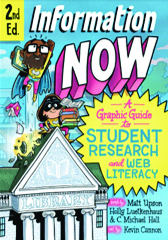 Can you believe my Technical Communication editor sent me a comic book to review? No, wait a minute, that’s not it at all! Imagine my pleasant surprise when this graphic novel, Information Now: A Graphic Guide to Student Research and Web Literacy by Matt Upson, Holly Luetkenhaus, C. Michael Hall, and Kevin Cannon turned out to be an excellent (and enjoyable) text on research procedures and web literacy.
Can you believe my Technical Communication editor sent me a comic book to review? No, wait a minute, that’s not it at all! Imagine my pleasant surprise when this graphic novel, Information Now: A Graphic Guide to Student Research and Web Literacy by Matt Upson, Holly Luetkenhaus, C. Michael Hall, and Kevin Cannon turned out to be an excellent (and enjoyable) text on research procedures and web literacy.
While the treatment is novel, and quite a departure from the usual academic presentation, the material is right on the mark. Once you adjust your “textbook” expectations, the authors present you with a most readable, highly organized, and quite thorough exploration of research methodologies covering all aspects from the Dewey Decimal system to advanced Web searches; from ethics and validity to bias and misinformation.
The initial chapters deal thoroughly with the details of information systems, data base types, search protocols, and so on. The authors bring rather dry subjects to life by witty writing and playful animation. Terminating each section is an excellent group of critical thinking exercises focused on the covered material. I found the questions to be well designed and quite usable.
The advice for evaluating sources is particularly well-developed. In Chapter 6, the authors discuss Mike Caulfield’s SIFT method (stop, investigate the source, find more [or better] coverage, and trace claims, quotes, and media back to their original content) for fact checking information found online (pp. 87–92). They also explore the different options students have when searching for information both on the Web and in academic journal databases.
Upson, Luetkenhaus, Hall, and Cannon explain well the complexities of algorithms and how they inherently bias and alter results when searching information randomly on the Web. That’s why their strategies on searching for and evaluating information are especially valuable.
The authors also give validity to Wikipedia and Google Search, two things I was happy to see because, like the authors, I argue that they are places to start any information search. Wikipedia has lists of references and Google Search provides the most popular search items. The book covers search strategies, both for the Web and for library databases, in detail and contains guidelines for using advanced features.
The comic book format makes it exceptionally easy to cover a significant amount of material in a most approachable manner. If this material were presented in a handbook, it would not be as engaging, clever, or innovative.
Having taught college composition classes, I would highly recommend Information Now as a superb companion text. The relatable dialogue, engaging graphics, and creative approach to the subject matter will keep students reading and even enjoying the book.
Lynne Cooke
Lynne Cooke is a Clinical Assistant Professor at Arizona State University where she teaches courses on usability, digital media, and portfolio development. She is also a member of the Arizona Chapter of STC and the Internship Coordinator at ASU.
Information Security Essentials: A Guide for Reporters, Editors, and Newsroom Leaders
Susan E. McGregor. 2021. Columbia University Press. [ISBN 978-0-231-19233-0. 222 pages, including index. US$30.00 (softcover).]
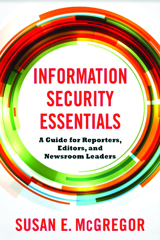 If you want a step-by-step guide of how to secure information in an abstract, “standard” newsroom, this is the wrong book. Risk assessment starts with the specifics of a particular organization and here, especially, the people working for it, Susan McGregor emphasizes. A young woman of color covering an incident in a mostly white rural area may face different threats than an older white man investigating the same incident.
If you want a step-by-step guide of how to secure information in an abstract, “standard” newsroom, this is the wrong book. Risk assessment starts with the specifics of a particular organization and here, especially, the people working for it, Susan McGregor emphasizes. A young woman of color covering an incident in a mostly white rural area may face different threats than an older white man investigating the same incident.
That said, McGregor does discuss specific steps that small, mid-sized, and large newsrooms should consider when designing their information security policies. However, such policies are only as good as their implementation—if they interfere too much with journalists’ newsgathering, they won’t be followed. Thus, editors and journalists must be included in decision-making about the processes and tools used to ensure that journalists, the information they gather, and the sources they consult are protected against threats—both in real life and online.
A thorough assessment of the news outlet’s processes—from receiving pitches, to researching stories and contacting sources, all the way to interacting with readers after the story has been published—should form the basis for determining potential vulnerabilities and how to address them. This includes considering the legal framework, reporting from the field or the home office, handling freelancers and community contributors, and moving the story through the editing and publishing process. McGregor covers all these topics and adds chapters on the threats faced by the profession as a whole and what the future may bring.
Information Security Essentials: A Guide for Reporters, Editors, and Newsroom Leaders is written for US-based journalists, editors, and news organizations. A chapter on reporting abroad addresses the special risks that crossing borders pose to equipment and notes. These risks are not limited to being in conflict zones, as the example of Seth Harp, a Rolling Stone reporter whose devices and notes were searched by US border patrol when he returned from a reporting trip to Mexico shows (pp. 78, 81). This is just one example that McGregor includes to illustrate the need for addressing specific information security concerns. She also includes examples of information security done right, such as a case study of journalists’ investigations based on the Panama Papers (a trove of leaked documents that exposed a network of financial wrongdoings). Check out www.icij.org/investigations/panama-papers/ for more information about this.
Many information security habits she suggests in chapter 4, Everyday Essentials, would be useful for non-journalists, too. Separating private and personal social media accounts, for example, keeps your boss from knowing about your aunt Sally’s habit of posting spicy videos to Facebook. Regularly backing up important data should be a matter of course for anyone who works with digital tools, but often takes a backseat to work on deadline.
Information Security Essentials is a good reminder of how important basic information security is for everyone, and how even non-journalists might benefit from auditing their devices and habits to secure their personal information.
Barbara Jungwirth
Barbara Jungwirth writes about medical topics (www.bjungwirth.com) and translates medical and technical documents from German into English (www.reliable-translations.com). She has written for print and online media since her high school days and majored in media studies. You can find her on Twitter at @bjungwirthNY.
Subconsciousness: Automatic Behavior and the Brain
Yves Agid. 2021. Columbia University Press. [ISBN 978-0-231-20127-8. 110 pages, including index. US$26.00 (softcover).]
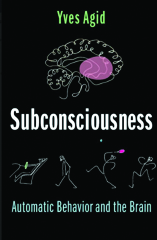 Subconsciousness: Automatic Behavior and the Brain delves into the poorly understood connection between structure and function in the brain-particularly regarding intentional and unintentional behavior. Yves Agid discusses this obscure subject in a 100-page treatise that links the cerebral cortex with the basal ganglia and argues that intentional and unintentional behavior arise from the engagement and disengagement of neural pathways in between. The author clarifies early in his book that subconsciousness is not the Freudian concept of the unconscious mind—primarily repressed mental content that affects behavior. Subconsciousness is not easily discernible, in contrast to the clear sense of consciousness or meta-consciousness. He narrates a first-person account of a traffic jam in Paris—noting the intentional decisions (consciousness) and self-talk (meta-consciousness) during each event in traffic. Autopilot—driving without intentionally thinking about choices and actions—is the work of the subconscious. Later in the book, Agid asks the question that if the brain is operating on autopilot, is it possible to decide (like when driving) without being aware that a decision was made? (The answer is yes). Herein lies some of the complexity of the subconscious.
Subconsciousness: Automatic Behavior and the Brain delves into the poorly understood connection between structure and function in the brain-particularly regarding intentional and unintentional behavior. Yves Agid discusses this obscure subject in a 100-page treatise that links the cerebral cortex with the basal ganglia and argues that intentional and unintentional behavior arise from the engagement and disengagement of neural pathways in between. The author clarifies early in his book that subconsciousness is not the Freudian concept of the unconscious mind—primarily repressed mental content that affects behavior. Subconsciousness is not easily discernible, in contrast to the clear sense of consciousness or meta-consciousness. He narrates a first-person account of a traffic jam in Paris—noting the intentional decisions (consciousness) and self-talk (meta-consciousness) during each event in traffic. Autopilot—driving without intentionally thinking about choices and actions—is the work of the subconscious. Later in the book, Agid asks the question that if the brain is operating on autopilot, is it possible to decide (like when driving) without being aware that a decision was made? (The answer is yes). Herein lies some of the complexity of the subconscious.
Text boxes are one method of highlighting important discoveries toward the link between structure and function in the brain. These pull-out boxes summarize case studies with significant outcomes. Box 4.3, for example, describes the famous psychiatrist Sigmund Freud’s rotation in a neurology department (pp. 82–83). This famous neurology research lab studied lesions in various parts of the brain. After death, an autopsy of the spinal cord and brain linked patient behavior while they were alive to the functionality of their brain postmortem. This early work led to the belief that links behavior to the health of various pathways in the different sections of the brain.
It is important to note that although Agid strongly argues that the basal ganglia are primarily responsible for the brain’s subconscious functions, it is very much in collaboration with the cerebral cortex. “The basal ganglia are faithful collaborators of the cerebral cortex . . . They are not alone, isolated, and cut off from the rest of the brain, as they involve the cerebral cortex every time they are activated, just as they are activated every time the cerebral cortex drives deliberate behavior” (p. 72). It is a feedback loop of sorts. This description is, of course, a simplification of the extremely complex process occurring. “One might say that this is a caricatured reductionist perspective” (p. 72).
Agid devotes an entire chapter to a discussion about deficiencies in the structure of the brain and how those correlate to functionality. Two diseases that illustrate this well are Alzheimer’s and Parkinson’s. In Alzheimer’s disease the patient has problems related to memory, language, and perception, all controlled by the cerebral cortex while with Parkinson’s the patient cannot perform routine tasks like brushing teeth, walking, and writing—all controlled by the basal ganglia. “These two pathologies are somehow mirrored, which suggests, but does not demonstrate, that the cerebral cortex plays a predominant rule in nonautomatic behaviors, and conversely, that basal ganglia dominate in automatic behaviors (p. 57).
Perhaps because it is unavailable, information is not given to directly support brain scans and the Alzheimer’s/cerebral cortex link versus the Parkinson’s/basal ganglia link. However, this lifelong researcher in the field of neurology and behavioral science seems convinced that link is probable.
Julie Kinyoun
Julie Kinyoun is an on-call chemistry instructor at various community colleges in Southern California. An avid reader, she enjoys reviewing books that help her become a better educator.
Long Players: Writers on the Albums that Shaped Them
Tom Gatti, ed. 2021. Bloomsbury Publishing. [ISBN 978-1-5266-2578-6. 216 pages. US$22.00 (hardcover).]
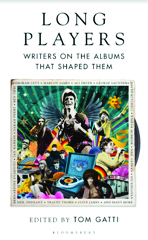 In Long Players: Writers on the Albums that Shaped Them, editor Tom Gatti tasks 50 contemporary writers with providing short essays discussing the albums that changed them. At their best, these essays not only provide insight into the art of the album but provide insight into the minds and lives of the writers themselves. When read individually, each essay situates the reader in a pivotal moment in the writer’s life as they find themself in the magic of song. Read as a whole, the book works as a fragmented paean to the power of music to transform and inspire that finds unity through an overriding feeling of wonder. Overall, the writers leave the reader with an impression of each album set in the intermediate space of criticism and memoir that can be both enchanting and frustrating.
In Long Players: Writers on the Albums that Shaped Them, editor Tom Gatti tasks 50 contemporary writers with providing short essays discussing the albums that changed them. At their best, these essays not only provide insight into the art of the album but provide insight into the minds and lives of the writers themselves. When read individually, each essay situates the reader in a pivotal moment in the writer’s life as they find themself in the magic of song. Read as a whole, the book works as a fragmented paean to the power of music to transform and inspire that finds unity through an overriding feeling of wonder. Overall, the writers leave the reader with an impression of each album set in the intermediate space of criticism and memoir that can be both enchanting and frustrating.
Gatti starts the book with a 25-page introduction in which he describes his personal history with the album and the album’s history through different eras of technological change before briefly stating how the book came to be. The 50 essays in this collection, around two-to-three pages each, feature a variety of types of writers and music, from popular fiction writer Neil Gaiman on David Bowie’s Diamond Dogs to 2015 Booker Prize-winner Marlon James on the experimental Icelandic singer Björk’s Post, from novelist Daisy Johnson on contemporary hip-hop/R&B artist Lizzo’s Cuz I Love You to literary stalwart Ben Okri writing on Miles Davis’ seminal Kind of Blue. Though the styles of writing and music vary, each essay centers around “just how deeply this form [the album] is embedded into our lives” (p. 23) rather than straight criticism. Essentially, the strength of this book is in lines like this one from Okri: “There are some rare albums that seem to lift from their physical condition and become part of the decor and mood of a life. They seem not to be music anymore but one of the things that shape you, like the home you grew up in, or your earliest toys, the fragrance of your mother’s hair, or the street where you first fell in love” (p. 135).
Long Players will appeal to most technical communicators who love music, who will find new musical artists and writers worth checking out as well as insights into old favorites. Some readers, however, may find themselves frustrated by the lack of analysis in some of the essays as to what makes the albums important as works of art.
Dylan Schrader
Dylan Schrader is a proposal developer at the University of Alabama in Huntsville, where he also earned an MA in Professional Communication and is working on an MA in English.
The Book Proposal Book: A Guide for Scholarly Authors
Laura Portwood-Stacer. 2021. Princeton University Press. [ISBN 978-0-691-20967-8. 198 pages, including index. US$19.95 (softcover).]
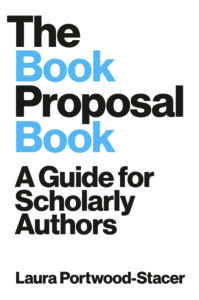 The title, The Book Proposal Book: A Guide for Scholarly Authors, is precise in exactly what this book is about and who it is for: scholars who want to pitch a book proposal to scholarly publishers, not commercial ones, about their own research. It is a guide for recent PhD graduates who want to turn their dissertation into a book and for all other scholars who want to go down the path toward publishing a book about their own research and work.
The title, The Book Proposal Book: A Guide for Scholarly Authors, is precise in exactly what this book is about and who it is for: scholars who want to pitch a book proposal to scholarly publishers, not commercial ones, about their own research. It is a guide for recent PhD graduates who want to turn their dissertation into a book and for all other scholars who want to go down the path toward publishing a book about their own research and work.
The subject of writing a book proposal may seem uninteresting to some readers, and unnecessary to others, but to get information, resources, and tools directly from an experienced scholarly publisher and scholarly author is priceless. I imagine most scholarly publishers are thankful that this guide exists, because even though most scholars know how to write about their own research, they often do not know how to pitch their writing or work. That is the central aim of Laura Portwood-Stacer’s book.
She has a readable style of writing, which makes getting through the book quite easy. The chapters are short, uniform, and full of helpful information, advice, templates, examples, and two consistent sections of Time-Tested Tips and FAQs. There are 14 chapters that break down 20 steps in the book proposal process that begins with choosing a publisher and writing a letter of inquiry, understanding what it means to find comparable works, writing a project description and chapter summaries, attending to style and voice, how to prepare all the pieces of a proposal package, and ends with “Permissions, Proofs, and Promotion.” Portwood-Stacer organized the book so that you can accomplish the necessary tasks for each step in the process in small blocks of time if that is what you find your schedule will allow.
Within the chapters, Portwood-Stacer explains common issues and mistakes that scholars encounter when thinking about or submitting book proposals. She offers experienced advice that may surprise you at times and may even be contrary to the advice of other experienced scholars, such as who to contact, when, and what chapters you may want to submit as sample chapters and when to do so. Back matter includes a checklist for the steps in the process and a longer checklist to help you assess your proposal materials, Sample Documents that include three different prospectuses, Suggestions for Further Reading, and Time-Tested Tips and FAQs by chapter, which is a time-saving resource to quickly find answers to commonly asked questions. The Book Proposal Book is well written, well organized, and a most helpful, reasonably priced guide for scholars of all ranks.
Diane Martinez
Diane Martinez is an associate professor of English at Western Carolina University where she teaches technical and professional writing. She previously worked as a technical writer in engineering, an online writing instructor, and an online writing center specialist. She has been with STC since 2005.
Speculation: A Cultural History from Aristotle to AI
Gayle Rogers. 2021. Columbia University Press. [ISBN 978-0-231-20021-9. 258 pages, including index. US$30.00 (softcover).]
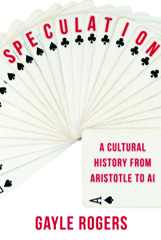 Gayle Rogers’ erudite study, Speculation: A Cultural History from Aristotle to AI, shows how changes in the word “speculation,” from its roots in Greek and Latin to its emergence in artificial intelligence (AI), illustrates aspects of European and American spiritual, philosophical, and financial history.
Gayle Rogers’ erudite study, Speculation: A Cultural History from Aristotle to AI, shows how changes in the word “speculation,” from its roots in Greek and Latin to its emergence in artificial intelligence (AI), illustrates aspects of European and American spiritual, philosophical, and financial history.
The word “speculation” originated in the Greek root -skop, to “see or view”; then, through a consonant shift, turned into the Latin word, spec. Latin usage introduced two variations: speculum meant both a physical mirror and introspective self-reflection; specula meant to observe unobserved from afar, as if from a watchtower.
Thus, a fundamental tension in the derivative word “speculation” was born: it could mean an inward, meditative, spiritual self-reflection, or an outward, object-oriented view of the world. The former meaning, posited by Boethius, invited deeper self-understanding, and was considered legitimate, a pathway to God; the latter, offering the opportunity to spy on and potentially exploit others, was deemed illegitimate, sinful.
With the advent of the scientific method, speculation in or about things or people became more acceptable. Speculation could now “be ‘drawn from matter’” (p. 47), if it was tempered by judgment. One could speculate about how to turn worldly things or people to advantage if the process was supported by empirical evidence and a sense of utility and proportion.
Industrialism and capitalism further cleansed speculation of its potential deceitfulness. Adam Smith “incorporated the gambling spirit of speculation into legitimate, even enlightened practices” (p. 81, emphasis in original), but again with a proviso: speculation had to be “grounded in the predictability of returns over time” (p. 80), and tied to something of material value, like gold.
Despite these efforts, contemporary schemes like the South Sea Bubble introduced a new problem: financial “expectation as a type of possessed madness” (p. 93). Initially diagnosed as a mental illness of the individual, then identified as the powerful bandwagon effect of crowds, speculation became synonymous with mania and feverish mass self-deceit.
In America, speculation, animated by the energy and raw “‘spirit’” (p. 92) of inventing a new country, created an atmosphere that prompted everyone—including marginalized groups like women—to bet on the market based on price fluctuations alone. New ticker tape technology “radically dematerialized” (p. 117) and intensified the “velocity and immateriality of speculation” (p. 118), turning information itself into a commodity for even further speculation, irrespective of its intrinsic economic value.
Today’s ticker tape is the networked computer, with ubiquitous electronic speculators increasingly dependent on sophisticated software to trade bits of ephemeral information, leading to the question: “Can machines speculate?” (p. 177).
Rogers does not answer definitively, perhaps because neither he nor anyone else can. He ends his impressively researched cultural history by noting that “‘every decision is a risk. Every risk is a decision’” (p. 180). If so, whether automation resolves speculative uncertainty is itself speculative, and as always, the only certainty may be the truism: “It depends.”
Donald R. Riccomini
Donald R. Riccomini is an STC member and was a senior lecturer in English at Santa Clara University, where he specialized in engineering and technical communications. He previously spent twenty-three years in high technology as a technical writer, engineer, and manager in semiconductors, instrumentation, and server development.
Tales of the Pen Master: Zen Stories for Editors, Proofreaders, and Other Publishing Professionals
Jack Lyon. 2021. The Editorium LLC. [ISBN 978-1-4341-0483-0. 76 pages. US$24.95 (hardcover).]
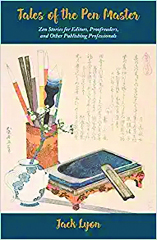 The book reviewer interrupts the Pen Master’s lunch with a question that has weighed upon his mind. “How,” he asks, “is one to review a book?” “One must first ask what the author’s goals are,” the Pen Master replies. “And how does one know that?” the reviewer wonders. The Pen Master ponders a moment. “If the author has whetted your appetite to learn more, then they have succeeded at their goal.”
The book reviewer interrupts the Pen Master’s lunch with a question that has weighed upon his mind. “How,” he asks, “is one to review a book?” “One must first ask what the author’s goals are,” the Pen Master replies. “And how does one know that?” the reviewer wonders. The Pen Master ponders a moment. “If the author has whetted your appetite to learn more, then they have succeeded at their goal.”
In the practice of Zen, a koan is a thought puzzle intended to make you challenge your certainties, and in so doing, undermine those certainties to achieve insights that will reframe your subsequent understanding. In Tales of the Pen Master: Zen Stories for Editors, Proofreaders, and Other Publishing Professionals, Jack Lyon serves a tasty feast of challenges to inspire that hunger in anyone who works with words.
Each chapter begins with a short koan crafted by Lyon to introduce a different and important editing concept, including rules, mechanics, technology, meaning, knowledge, and the elusive nature of perfection. Tales of the Pen Master is full of simple yet profound wisdoms on a wide range of subjects. He enhances each topic by including both modern and ancient koans that provide further food for thought. Throughout, he emphasizes the self-effacing goal of editing: to clarify the author’s message and convey it as effectively as possible to their readers.
Lyon notes that “even if you know ‘the rules,’ editing is not about making sure a manuscript always follows them”; in this concise book, it’s the job of the Pen Master “to open the minds of editors and proofreaders everywhere” to understanding (p. ix). Tales of the Pen Master accomplishes this with the same elegance as the many watercolor reproductions that illuminate the book and shed light on its meaning.
This slim book is not one to be devoured in a single sitting, but rather something to be savored, perhaps at a rate of a single chapter per day, to give yourself time to ponder and learn. And to start over again once you reach the end, for the journey to wisdom is iterative, not a one-way trip. Tales of the Pen Master would make a great gift for the editor in your life—or for yourself.
Geoff Hart
Geoff Hart is an STC Fellow with more than 30 years of writing, scientific editing, translation, and information design experience. He’s the author of two popular books, Effective Onscreen Editing and Write Faster With Your Word Processor.
What Are the Chances?: Why We Believe in Luck
Barbara Blatchley. 2021. Columbia University Press. [ISBN 978-0-231-19868-4. 240 pages, including index. US$27.95 (hardcover).]
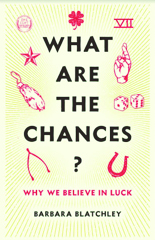 Barbara Blatchley’s What Are the Chances?: Why We Believe in Luck is about our belief in luck and its role in our lives. The book includes many stories about “lucky” or “unlucky” people that are explored through the lenses of psychology and neuroscience. Through this exploration, Blatchley touches many subjects: history, magic, religion, randomness/chaos, statistics, perception, and many more.
Barbara Blatchley’s What Are the Chances?: Why We Believe in Luck is about our belief in luck and its role in our lives. The book includes many stories about “lucky” or “unlucky” people that are explored through the lenses of psychology and neuroscience. Through this exploration, Blatchley touches many subjects: history, magic, religion, randomness/chaos, statistics, perception, and many more.
You don’t need to be a psychologist or neuroscientist to understand the book because Blatchley is excellent at explaining the complex ideas and even reminding you of the concepts when she revisits them in later chapters. In fact, what makes this book accessible to the average reader, makes it insufficient to anyone that understands the current research on the topic. Blatchley introduces the study of luck, providing a synopsis of a vast amount of research as evident by the 20 pages of notes and the 14-page bibliography.
All this research comes to the consensus that our “illogical” belief in luck actually “makes us feel less anxious. When we’re less anxious, we can devote more of our mental energy to solving the problem. Success is a feed-forward loop; it breeds itself, and we feel lucky” (p. 190). As a result, luck is “like the placebo effect in medicine. If I believe that this little green pill will make me feel better, and when I take it, I feel better, does it really matter what is in the pill?” (p. 187). Not to Blatchley, who admits she owns a lucky pair of shoes herself.
If, like me, you’ve scoffed at lucky talismans or rituals in the past, you might benefit from Chapter 7, “How to Get Lucky,” which provides the characteristics of “lucky” people. Blatchley’s point being that we can all be lucky if we learn to adopt these characteristics. In conclusion, if you’re looking for insight on the history of luck, why we believe in it, or want to know how to be “lucky,” then What Are the Chances? is worth the read.
Sara Buchanan
Sara Buchanan is an STC member and a content strategist at LCS in Cincinnati, Ohio. In her free time, she’s an avid reader, enjoys cooking, and doting on her cats: Buffy and Spike.
Educating Tomorrow: Learning for the Post-Pandemic World
Chris Brown and Ruth Luzmore. 2021. Emerald Publishing. [ISBN 978-1-80043-663-3. 188 pages, including index. US$23.99 (softcover).]
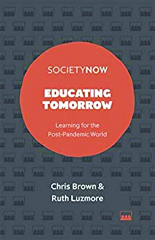 Does a post-pandemic world provide us with a blank slate for change in society overall and education in particular? That is a question Chris Brown and Ruth Luzmore ask in Educating Tomorrow: Learning for the Post-Pandemic World.
Does a post-pandemic world provide us with a blank slate for change in society overall and education in particular? That is a question Chris Brown and Ruth Luzmore ask in Educating Tomorrow: Learning for the Post-Pandemic World.
Can education emerge as new and improved in the post-pandemic future? Can we take the global challenges we now face and make a better tomorrow? Brown and Luzmore also address these questions in Educating Tomorrow. Their thoughts provide great food for thought.
Brown is a professor at Durham University (UK) and Luzmore is a primary school teacher in London and PhD student at Durham. Their perspective in Educating Tomorrow reflects ideas related to how England’s educational system could change in the future due to not only the aftermath of the pandemic but also due to global environmental and democratic changes.
To give an idea of the scope of topics covered, consider how the authors summarize in a table the purpose of education over time (pp. 71–73). As a sampling from the table, in ancient Greece, there is no formal public education. During the rise and fall of Rome, the table shows a “widespread system of education with the purpose of preparing boys of wealth to enter the government” (p. 70). During the industrial revolution, “private education continues for those who can afford it” (p. 72). In what the authors call the welfare state, there is a “radical change in offer of education until age 16” (p. 72).
If you (or your students) enjoy thinking about topics covered in a chapter such as a Brief History of Education from Ancient Greece to the Enlightenment (p. 39) or From Universal Basic Income to Aristotle and Back (p. 101), this would be a good read for you.
Only time will tell if there are changes in society and education in a post-pandemic world, and we can, of course, hope for changes that could be considered a better world in the future.
Jeanette Evans
Jeanette Evans is an STC Associate Fellow; active in the Ohio STC community, currently serving on the newsletter committee; and co-author of an Intercom column on emerging technologies in education. She holds an MS in technical communication management from Mercer University and undergrad degree in education.
Write Here: Developing Writing Skills in a Media-Driven World
Randi Brummett de Leon and Brooke Hughes. 2020. Broadview Press. [ISBN 978-1-55481-477-0. 384 pages, including index. US$49.95 (softcover).]
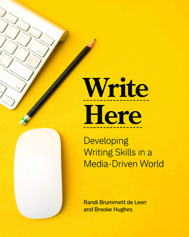 Media now certainly drives the world and social media has become an inseparable part of human life. Randi Brummett de Leon and Brooke Hughes could not have waited for a more opportune time to plan a book like this, which “is designed to teach you essential reading and writing skills, using media examples to help explain academic concepts and provide opportunities for practice” (p. 12).
Media now certainly drives the world and social media has become an inseparable part of human life. Randi Brummett de Leon and Brooke Hughes could not have waited for a more opportune time to plan a book like this, which “is designed to teach you essential reading and writing skills, using media examples to help explain academic concepts and provide opportunities for practice” (p. 12).
Thoughtfully divided into four parts, Write Here: Developing Writing Skills in a Media-Driven World houses learning materials for core skills like reading and writing in Part I, media studies in Part II, academic writing in Part III, and writing basics in Part IV. Each part then has multiple scope-defined chapters. By design, each chapter in the book pays special attention to sufficient self-assessment of learning.
Part I – Connecting Reading and Writing deals with the reading and the writing skills in greater detail. The chapter on Reading covers pre-reading, rereading, and post-reading activities; the chapters around Writing discuss prewriting and rewriting phases, as well as essay writing. The emphasis on core writing can be felt as students progress through the chapters on parallels between reading and writing, modes of writing, timed writing, rhetoric, and errors in thought.
Part II – Analyzing the Media deals with basic concepts around social media, advertisements, news, and television. This part briefly explains the purpose, the audience, and the types of these media elements. The writing prompts, discussion topics, class debates—such essentials establish that this book can be a practical classroom guide.
The complete research paper process—from topic selection to framing the research question, to linking the purpose and audience, to framing the thesis statement and exploring the sources, through organizing research to preparing the draft—is covered in Part III – Exploring Academic Writing. It also discusses the efficient ways of using sources in research and educates briefly about plagiarism. The chapter around MLA/APA Documentation styles makes this part more comprehensive.
In Part IV – Polishing Your Writing, the authors intend to brush up the students’ grammar basics. This part is designed to revisit the elements of foundational grammar so they can approach their writing with confidence. For those who just need to revise their grammar fundamentals, such as parts of speech, subject–verb agreement, pronoun–antecedent agreement, fragments, run-ons, punctuation, and easily confused words, shall find this part useful.
The “Assessing Your Knowledge” and “Deepening Your Understanding” sections at the end of each chapter will come in handy for serious learners to evaluate their learning. The authors by their example exercises have provided necessary guidance to the readers to attempt their turn.
Leon and Hughes have assembled in Write Here all elements that students of a developmental composition classroom would be required to master. Written in a conversational tone and replete with contextual examples, this book offers a great learning experience to its readers.
Arun Dash
Arun Dash works as a Staff Technical Author for Salesforce, Hyderabad, India. With over a decade of technical writing experience, he has experimented with writing for various domains. He now continues his PhD in English from KIIT University, Bhubaneswar.
Visual Communication: Insights and Strategies
Janis Teruggi Page and Margaret Duffy. 2022. Wiley- Blackwell. [ISBN 978-1-119-22647-5. 322 pages, including index. US$59.95 (softcover).]
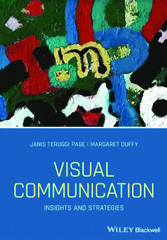
Visual Communication: Insights and Strategies is a great, informative textbook that explores the use of visuals in different industries, strategies to understand images impact and functions, and guidance to create effective and ethical visual communication. Janis Teruggi Page and Margaret Duffy argue the importance of understanding visual culture now more than ever due to changes in technology and the effects this has on how people process and interpret visuals. After introducing the idea of visual culture, the authors use research and theory to demonstrate the importance of their three-step process—research, evaluate, create—for visual imagery. Page and Duffy provide opportunities for the reader to apply this three-step process to several different aspects of visual imagery including sign language, storytelling, and artifacts. This process engages the reader with the material and provides an opportunity to create their own visual imagery.
Page and Duffy demonstrate how an image is worth much more than 1,000 words and can have just as many interpretations based on rhetorical choices. The book explains how visual imagery is much more complex than just an image by exploring the use of metaphors as a means of understanding, the value of ethics in creating visual imagery, the science behind semiotics, and additional elements. The authors offer this expansive understanding of how visual imagery can be interpreted or understood before investigating how their research can be used to execute visual imagery in different industries. An examination of cultural and environmental effects on how individuals interpret images and their meanings adds an unexpected idea of considering ethics when creating content, which is valuable in a society that obtains most of their content through visuals.
The authors use modern examples, such as memes and recent political campaigns, to prove that visual imagery is growing in importance in storytelling, marketing, politics, and pop culture, and shows how technology can be used to enhance our understanding and creation of visual imagery. The provided examples are relevant in time and context to their research helping their audience to further understand and execute the practices presented in Visual Communication.
I enjoy the simplistic structure of the textbook. Each chapter provides key learning objectives, a chapter overview, key terms, and practice activities that tests the reader’s knowledge of what was discussed in the chapter individually or in a classroom conversation. Additionally, throughout each chapter there are “focus” sections that provide examples demonstrating the research and information provided in the chapter. Each chapter is organized and separated according to the learning objectives providing an exact focus and making it a simple, yet effective way of learning.
Visual Communication: Insights and Strategies accomplishes the goal of providing strategies to create and critically evaluate visual imagery in several different industries. The book would be a great resource for students being introduced to marketing, public relations, or communications.
Meagan Lowney
Meagan Lowney is a graduate student at Kennesaw State University (KSU) pursuing an MA in Professional Writing. She currently serves as the Managing Editor for The Broadside, the Department of English’s digital newsletter at KSU.
Bernoulli’s Fallacy: Statistical Illogic and the Crisis of Modern Science
Aubrey Clayton. 2021. Columbia University Press. [ISBN 978-0-231-19994-0. 368 pages, including index. US$34.95 (hardcover).]
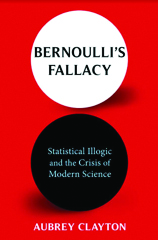 Modern science is amid an ongoing crisis. Many fields, especially those fields that rely heavily on testing and statistical reasoning—psychology, sociology, medical research, and more—are finding that upwards of half the research studies done in recent decades cannot be replicated.
Modern science is amid an ongoing crisis. Many fields, especially those fields that rely heavily on testing and statistical reasoning—psychology, sociology, medical research, and more—are finding that upwards of half the research studies done in recent decades cannot be replicated.
In Bernoulli’s Fallacy: Statistical Illogic and the Crisis of Modern Science, Aubrey Clayton tackles the crisis head on. In a brilliant blend of history and logical reasoning, he argues that the crisis is rooted in a fundamental logical flaw in our thinking about probability.
Briefly stated here, but clearly and carefully explained in the book, modern statistical methodology—normal distributions, null hypotheses testing, p-values, chi-squares, and all the rest—is about the frequency distribution of sampling errors, and, it turns out, sampling probabilities, taken alone, simply do not provide sufficient grounds for making sound inferences about the world. You also need a way to factor in your current state of knowledge including such things as conditional probabilities, alternative explanations for observed data, and more.
As early as the mid-1700s, Thomas Bayes developed a framework—Bayes’ theorem—that uses inductive reasoning and conditional probabilities to estimate the degree of confidence one might place in various hypotheses about observed data. Bayesian methods, too, are not without their problems, and for much of the ensuing centuries the relative merits of frequentist versus Bayesian approaches were subject to lively debate.
To explain how Bayesian methods came to be marginalized, Clayton traces the development of modern statistics, primarily through the work of three major innovators of frequentist methods: Francis Galton, Karl Pearson, and Ronald Fisher. In tandem with their influential statistical work, they each played leading roles in the eugenics movement. To bolster the credibility of both their statistical project and their social agenda, they fought a largely successful “frequentist Jihad” to purge the practice of statistics of any hint of Bayesian inferential reasoning—henceforth probability would mean sampling frequency and nothing more.
To illustrate, and help us avoid, the logical traps inherent in frequentist methods, Clayton walks us through a variety of intriguing statistical problems ranging from brain teasers like the “Monte Hall” problem, to real-world problems involving statistical reasoning: psychological testing, courtroom argument, medical diagnosis, and more. In each he shows how current frequentist methods lead to problems, and how the use of Bayesian methods lead to better results.
Clayton does not claim originality for his arguments and says they can all be found in the statistical literature. That said, Clayton is an excellent writer. In making the Bayesian case, he has clearly related the fascinating history of the development of statistical methods and has made key issues usually known only to specialists accessible to a broad audience. Whether you are a statistician, a working scientist, or an interested layperson, Bernoulli’s Fallacy is science writing at its best and should be well worth your while.
Patrick Lufkin
Patrick Lufkin is an STC Fellow with experience in computer documentation, newsletter production, and public relations. He reads widely in science, history, and current affairs, as well as on writing and editing. He chairs the Gordon Scholarship for technical communication and co-chairs the Northern California Technical Communication competition.
Write Faster with Your Word Processor
Geoff Hart. 2021. Diaskeuasis Publishing. [ISBN 978-1-927972-29-8. 358 pages, including index. US$22.00 (softcover).]
 Geoff Hart’s Write Faster with Your Word Processor is about “mastering the tools you use to craft fine writing…so well that you stop focusing on the mechanics of writing and pay more attention to the craft” (p. 1). This book takes you through the aspects of writing any type of genre with a word processor. While Hart’s book mostly talks about Microsoft Word, he does state emphatically throughout that many of his tips, tricks, or techniques are transferable to any other word processing software. What I enjoyed the most is seeing some of the things I had forgotten about Microsoft Word and learning a few new things that I was not aware of.
Geoff Hart’s Write Faster with Your Word Processor is about “mastering the tools you use to craft fine writing…so well that you stop focusing on the mechanics of writing and pay more attention to the craft” (p. 1). This book takes you through the aspects of writing any type of genre with a word processor. While Hart’s book mostly talks about Microsoft Word, he does state emphatically throughout that many of his tips, tricks, or techniques are transferable to any other word processing software. What I enjoyed the most is seeing some of the things I had forgotten about Microsoft Word and learning a few new things that I was not aware of.
Writer Faster with Your Word Processor is broken into four parts. Part 1 covers getting started where you learn how to personalize how your computer works and develop safeguards; Part 2 is about writing your first draft; Part 3 is about revising your draft; and Part 4 covers appendices and miscellaneous resources. This book is not meant to be read cover to cover. Hart has written this as a reference book so that you can go to the chapter you want to read, learn, and put that learning into practice.
Chapter 7, “Moving Around,” gives tips on creating macros or using Microsoft shortcut keys for jumping through sections. I use the standard ones in common find-and-replace searches: ^p (paragraph symbol, ¶) and ^t (tab symbol, →). I learned through Hart’s book about ^m (manual page break), ^b (section break), and ^l (ell, line break). These will now improve my find-and-replace usage tremendously. He does provide an extensive list of ^ shortcuts for find and replace on pp. 172–173. I encourage you to read this chapter to learn more about these useful shortcut keys. Another movement tip describes the use of the F2 key to select and move text from one location in your Word document to a different location without the need of our friend, copy and paste (p. 100).
With today’s use of the Internet as our main library and resource center, Hart lists several reasons to use the Internet effectively in Chapter 10, “Use the Internet.” He does caution that you look for and consider author bias for any online resource or reference you do use. He suggests consulting more than one source to draw your own conclusions to improve your writing.
Styles and templates, shortcut keys, and use of the Internet: these are the few things that writers rely on every day. In Chapter 11, “Develop Style Sheets,” Hart has a table in the “Using a Style Sheet” section that provides tips on writing down the computer terms, formatting, and structural/sequence usages in your own writing. You can use this table to ensure that consistency in your writing is not left until the last minute.
The final section I enjoyed was “Appendix III: Word Keyboard Shortcuts (Plus Selected Operating System Shortcuts).” The one drawback here is that the information is in paragraph format where it might have been better represented in a tabular format for easier use as a reference.
While the book does not have exercises, you should be able to read and practice using your own examples. Unfortunately, it has no graphics, is written in a dense style, lacks use of white space making it difficult to read, and does not stay flat when trying to use it to practice the concept. Overall, Write Faster with Your Word Processor is a reference book that will help those new to word processors or those more experienced that may need a reminder of the features available to increase our productivity.
Jackie Damrau
Jackie Damrau is an STC Fellow with more than 25 years of technical communication experience. She serves STC in as the book review editor for Technical Communication and is also the Co-chair of the 2021-2022 STC Education Committee.
Design for Safety
Eva PenzeyMoog. 2021. A Book Apart. [ISBN 978-1-952616-09-9]. 154 pages, including index. US$24.00 (softcover).]
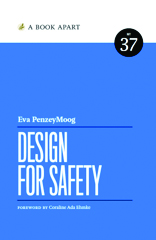 Every now and again, a book comes along that totally changes your perspective. Design for Safety by Eva PenzeyMoog was that book for me. Before reading this book, I had heard a few horror stories about women being stalked by someone through their running app or of jealous exes tracking victims through social media, but I never realized the true dangers involved with the Internet of Things (IoT) technologies that we use in our everyday lives. In Design for Safety, PenzeyMoog not only describes many of these security loopholes, but she also explains how designers can anticipate some of these security flaws and include safety into the design process.
Every now and again, a book comes along that totally changes your perspective. Design for Safety by Eva PenzeyMoog was that book for me. Before reading this book, I had heard a few horror stories about women being stalked by someone through their running app or of jealous exes tracking victims through social media, but I never realized the true dangers involved with the Internet of Things (IoT) technologies that we use in our everyday lives. In Design for Safety, PenzeyMoog not only describes many of these security loopholes, but she also explains how designers can anticipate some of these security flaws and include safety into the design process.
Design for Safety is a book on a mission. PenzeyMoog’s goal is to stop technology-facilitated violence (TFDV) (pp. i–iii). One in three American women and one in four American men will experience violence from an intimate partner in their lifetimes. The data contained in our technologies can facilitate this abuse by giving away location data and other personal information (p. 1). Often, the user doesn’t even know that they have consented to the collection of this data, or they do not know how to, or are unable to, stop its collection.
The author uses personal accounts from TFDV victims to illustrate how easily an unsuspecting person can be tracked or harassed through the technologies they use every day. These vignettes illustrate how something as basic as a smart thermostat or a grocery store app can become weaponized to cause distress. PenzeyMoog uses practical examples, such as the development of car seatbelt safety laws, to explain how citizens can fight back against companies that are unwilling to provide basic safety features (p. 116).
Despite her assertion that companies will often choose expediency and profit over safety (p. 112), industry technology developers and usability experts can learn from this book. Chapter 5 contains concrete suggestions for including safety measures and closing security loopholes at every step of the process, from planning to design and even in the writing of the user documentation.
Academics can benefit from reading Design for Safety as well. Any academic researching or teaching usability would discover a gold mine of information about identifying representative participants for usability tests in Chapter 6, as well as about designing sensitive test questions and remote interview strategies for users who have been TFDV survivors. I plan to include a discussion of the ethical design of IoT technologies as part of my Web Publishing class to help my students understand the power of data collection and the implications of its misuse.
Nicole St. Germaine
Nicole St. Germaine is a Professor in the Technical and Business Writing Program at Angelo State University, as well as a freelance writer and consultant. Her research interests include technical communication for a Mexican American audience and technical communication in the health fields.
CAPS LOCK: How Capitalism Took Hold of Graphic Design, and How to Escape from It
Ruben Pater. 2021. Valiz. [ISBN 978-94-92095-81-7. 556 pages, including index. US$27.50 (softcover).]
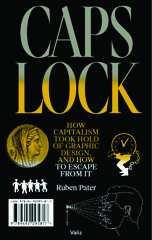 CAPS LOCK: How Capitalism Took Hold of Graphic Design, and How to Escape from It by Dutch author and graphic designer Ruben Pater is broken into four parts, in which Pater examines the history of capitalism from various aspects of the design practice, including the designer as scribe, brander, salesperson, worker, amateur, and educator, among others. Some of the connections to capitalism may seem obvious, such as the brander, salesperson, and even the worker, Pater makes connections to all these identities to the continued promotion and proliferation of graphic design as a deeply entrenched capitalistic practice and shows that even some well-intentioned identities, such as the designer as futurist and philanthropist may not have the outcomes expected when greedy corporations appropriate their work for profit.
CAPS LOCK: How Capitalism Took Hold of Graphic Design, and How to Escape from It by Dutch author and graphic designer Ruben Pater is broken into four parts, in which Pater examines the history of capitalism from various aspects of the design practice, including the designer as scribe, brander, salesperson, worker, amateur, and educator, among others. Some of the connections to capitalism may seem obvious, such as the brander, salesperson, and even the worker, Pater makes connections to all these identities to the continued promotion and proliferation of graphic design as a deeply entrenched capitalistic practice and shows that even some well-intentioned identities, such as the designer as futurist and philanthropist may not have the outcomes expected when greedy corporations appropriate their work for profit.
The “The Designer as Scribe” section examines the history of graphic design and makes ties to capitalism as far back as the first writing systems and shows that the first uses of the Ancient Mesopotamian writing system known today as cuneiform was for receipts and accounting purposes—in other words, to support capitalism. Readers may also be surprised to learn that capitalism had well-intentioned beginnings. Pater describes the rise of capitalism out of the Enlightenment era, where individuals sought to break free from the feudal past when most people were beholden to landowners or the aristocracy. However, he goes on to show that, “Capitalism has failed to deliver on its promise that it would create an economic system of freedom and prosperity for all” (p. 7).
CAPS LOCK describes the historical and continued inequities of design practice including marginalization as an unequal access to the profession, pay, and leadership roles by minorities, women, and individuals who identify as LGBTQ. It points to a long history of racism in advertising used to promote products that were developed through the exploitation of cheap labor and slavery and shows that exploitation still exists when design students receive unpaid internships. A practice that continues to perpetuate inequities in the profession. Of course, this issue offers an obvious solution, which is to pay your interns.
CAPS LOCK is at once a history and a criticism of the capitalist practices that define most aspects of the graphic design profession as we know it today. For those who are struggling to break from the capitalist tendency of the graphic design profession, at times the contents of this book will seem bleak, as it shows, “Through its anti-capitalist critique, graphic design has become more, not less entangled with capitalism” (p. 5). Yet despite the scathing criticism the book offers, it presents hope for designers who wish to “escape.” Part III presents accounts of practices that push back and embrace community over profit. Pater examines five design-based cooperatives to show how nonhierarchical approaches to design practice can exist, where co-design is practiced, and individual designers are not heralded as creative genius over the work of the group, showing that with work one could break free from the capitalist-driven practice of graphic design.
Amanda Horton
Amanda Horton holds an MFA in Design and currently teaches graduate and undergraduate courses at the University of Central Oklahoma (UCO) in the areas of design history, theory, and criticism. She is also the director of the Design History Minor at UCO.
XQuery for Humanists
Clifford B. Anderson and Joseph C. Wicentowski. 2020. Texas A&M University Press. [ISBN 978-1-62349-829-0. 350 pages, including index. US$50.00 (softcover).]
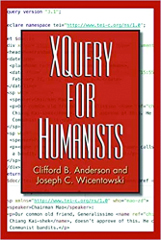 XQuery is an incredibly useful language for querying and transforming XML documents. As an information architect, my team and I have recently been tasked with learning XQuery so that we can search across numerous large XML documents and ensure the information contained within conforms to certain requirements. While I don’t fall into this book’s primary audience of scholars in the digital humanities, I was nonetheless intrigued by XQuery for Humanists’ pledge to ease the reader into what can be an intimidating language. I’m pleased to report that this book delivers on that promise.
XQuery is an incredibly useful language for querying and transforming XML documents. As an information architect, my team and I have recently been tasked with learning XQuery so that we can search across numerous large XML documents and ensure the information contained within conforms to certain requirements. While I don’t fall into this book’s primary audience of scholars in the digital humanities, I was nonetheless intrigued by XQuery for Humanists’ pledge to ease the reader into what can be an intimidating language. I’m pleased to report that this book delivers on that promise.
Whereas other, more programmer-oriented, books might present new concepts using examples from math (“Let’s write a simple function that returns the factorial of your argument”), XQuery for Humanists illustrates its concepts with poems, prose, or library catalog entries. This helps make an admittedly still-difficult subject about as easy as it can be.
I would recommend any reader to follow along with the numerous code samples by entering them into your chosen XQuery processor, as I did for much of the book. As with any text of this nature, the true leaps in learning will come only alongside practice; merely reading from cover to cover will provide limited benefits. Each of the book’s thirteen chapters concludes with questions and exercises to solidify your understanding of the concepts. I found that the exercises were just the right difficulty, being not too overwhelming but often prompting me to go back through the chapter to review specifics. I can’t image a better XQuery textbook for a graduate-level course than this.
Reading XQuery for Humanists feels like an extended one-on-one office session with a wise, experienced colleague. Clifford B. Anderson and Joseph C. Wicentowski taught this material in seminars for several years before writing this book. Their experience shows in the way that they seemingly anticipate follow-up questions every time they introduce a new concept. I also greatly appreciate how they are quick to alert the reader to obscure, program-breaking quirks as soon as you need to know them.
If you are a non-programmer who regularly deals with documents encoded in XML, TEI, DITA, or other structured markup languages, learning even a modicum of XQuery will put you head-and-shoulders above your peers. If nothing else, you should read this book to open your eyes to the world of possibilities awaiting you once you learn how to process text efficiently and programmatically.
Josh Anderson
Josh Anderson, CPTC, is an Associate Information Architect at Precision Content. He was an English teacher in Japan and an SEO Specialist in the Chicagoland area before earning a Master of Information at the University of Toronto.

